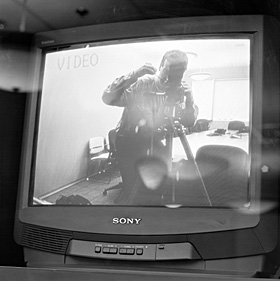| IMAGES> 
Self Portrait, 25 February 1998 | | Looking the corporation exactly in the eye.
I still remember my first sight of an American corporation.
I was nineteen, a student at the Novosibirsk Institute for Advanced Political Studies. Professor Vladimir Izvestikov, a young party apparatchik, passed around a copy of The Naked Face of Capitalism. The ancient, dog-eared publication featured contrasty black and white photos of exhausted miners, numbed worker drones on wretched production lines, pitiful child laborers, destitute mothers with filthy children selling apples on the street corners, monstrously hellish factories belching oceans of sooty black smoke, unemployment queues stretching into the horizon, that sort of thing. And in case those visual clues weren’t enough to convince even the photographically illiterate reader of the evils inherent in the corporation’s enslavement of subjugated workers, there were still more photographs: of the filthy rich.
There they were: the bourgeois capitalists, smugly enjoying the ill-gotten fruits of their domination of the proletariat. There they were in their luxurious surroundings, with acres of food and drink, sunny opulent staterooms, and all the creature comforts they denied the long-suffering workers.
And so on.
That was, of course, a long, long time ago in a country that no longer exists. After perestroika, after glasnost, no one shows photographs of corporations any more. We’re all capitalists now. Who cares?
No one, that is, until I was asked to comment on a curious selection of images, Of What is Adobe Made?
The work, by David Glenn Rinehart, is “a visual exploration of an invisible entity, a corporation.” Rinehart has made this daunting task even more difficult by graphically depicting what is essentially a conceptual legal construct that “manufactures” an invisible product, software. Or, in the jargon of the turn of the century, “intellectual property.”
Rinehart set an extraordinarily ambitious goal for himself, an objective he spectacularly failed to reach.
Not even close.
Rinehart’s images fail to describe the “real” nature of the contemporary information technology corporation. Or, more to the point, they obscure whatever vision one may have had about such an institution.
To be charitable, I am reminded of Robert Heinecken’s observation, “The function of art is not necessarily one of clarity.” Although the images Rinehart made with his Hasselblad are technically clear, they are conceptually opaque. Of What is Adobe Made? is a question Rinehart has failed to answer.
Rinehart shows us the anonymous façade of the corporate skyscraper—anonymous except for the obligatory corporate logo—then takes us behind it. And what do we see? There’s a photograph of a boiler, a rather clean boiler, the kind of boiler one might see in a boiler museum. There are hundreds of automobile batteries on shelves. There are clean, sunlit offices, filled with whimsical decorations, if not hundreds of toys. There’s a refrigerator full of free soft drinks. In some ways, the world of an Adobe worker resembles nothing so much as the world of the ruling capitalists as depicted in The Naked Face of Capitalism. Except ...
Except: where are the workers?
The Adobe headquarters Rinehart shows us appears to have been struck by a neutron bomb. Everything’s there, everything except for the people. We see them, barely, as ghosts on the vellum that separate the prints.
Is there a message here? I don’t think so. I think the only message Rinehart has for us is in the title of the portfolio, Of What is Adobe Made? It is worth noting that Rinehart did not call his work, What Adobe’s Made Of.
The visual and aesthetic approach Rinehart has taken in Of What is Adobe Made? is perhaps to have been expected. After all, it’s almost a given in contemporary art near the beginning of the twenty-first century that it’s much, much better to ask questions than to answer them.
Rinehart has indeed asked some interesting questions in Of What is Adobe Made? As for answers, anyone interested in the “real” nature of the modern corporation will have to look elsewhere.
Dr. Natasha Solnitskaya
Novosibirsk, February 2002
(translated by S. Jüngling) IMAGES> |